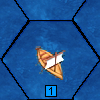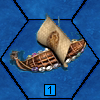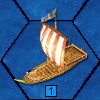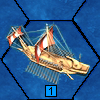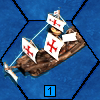The ships (Construction, equipment and properties): Difference between revisions
Siegfried.II (talk | contribs) (New page: == General information concerning ships == Ships are needed to explore the world and chiefly to transport armies and spies to other islands or to attack hostile fleets. You can move ships...) |
No edit summary |
||
| (19 intermediate revisions by 3 users not shown) | |||
| Line 1: | Line 1: | ||
== General information | == General information on ships == | ||
Ships are needed to explore the | Ships are needed in L&L to explore the map, transport armies and spies to other islands or attack enemy ships. Just as individual units are grouped into armies, your ships are grouped into fleets. | ||
Like armies and spies, fleets are moved via the pop-up on the map (by right-clicking) or by entering the moves in the field view. You can also enter a target field for fleets. However, this must be uncovered (sea or own or alliance harbor) when you enter it. This makes it easier to ship supplies or unite your fleets, but does not automatically allow you to explore the map. | |||
All | All fleets have a visibility of 3 fields. The maximum possible speed is 6 hexes per tick and is determined by the slowest ship in the fleet. | ||
== | == Fleet construction == | ||
Fleets are built in [[harbor|ports]]. Each port can only build one fleet at a time. How long it takes to build a fleet depends on the type and number of ships. Ports with a high expansion level can build ships much faster. The training quality of the crew (= XP) also increases with the port level, which is an important factor for success in naval battles. | |||
At the beginning, only Knarrs can be built. Through [[Research|Exploration]] of the Seafaring path, the construction of larger ship types becomes possible. By building a shipyard (harbor slot), the construction of ships can be further accelerated and the construction costs reduced. | |||
Each ship type offers a different amount of cargo space, which is required to transport troops or spies. How many cargo space points a unit requires is listed under "The units" or "Loading and unloading ships". When building, you should also bear in mind that only Knarrs and Drakkar can deploy armies directly to coasts. | |||
The | The construction menu shows how many resources the construction will require (1), the speed of the fleet (2), the number of sailors required (3), the cargo space of the fleet (4), and how many units can be placed on land per turn (5). | ||
As soon as you are satisfied with the composition of your fleet and you have sufficient resources to build it, you only need to give the fleet a name and click on the "Build fleet" button. | |||
[[File:Schiffbau_eng.jpg|Schiffbau]] | |||
''You can cancel the building of a fleet anytime. 90% of the used resources will be refunded.'' | |||
== Operational readiness, damage and repairs == | |||
''Version 5.0'' | |||
[[ | #Newly built fleets have an '''operational readiness''' of 150%. Each round at sea reduces the operational readiness by 0.25% (near the coast) or 0.5% (open sea). | ||
#Fleets can be damaged by [[Battles at sea|naval battles]] or if the [[LaL-Calculator_and_Formulary_(from_all_areas)#Calculation_of_the_upper_limit_of_fleets|fleet limit]] is exceeded. This reduces the '''operational readiness''' of the fleet | |||
#Fleets with an operational readiness of <100% have correspondingly less loading capacity and speed. The operational readiness of a fleet cannot drop below 10%. The speed of a fleet cannot drop below 1. | |||
#Overloaded fleets lose excess units. Generals cannot be lost, even if the number of troops is 0. | |||
#Fleets with an operational readiness of < 100% can only use a correspondingly reduced number of sailors in boarding combat. | |||
#The operational readiness of fleets is automatically increased again when they are in their own or alliance port. The duration and cost of the repair correspond to the usual construction costs. The level of the port, the research, and the presence of a shipyard are also taken into account. From 100%, a further increase in operational readiness (up to a maximum of 150%) only costs 20% of the usual costs (with the exception of bread, here the full costs are paid). | |||
== | == Ship types == | ||
''Numbers in brackets are valid since version 4.2'' | |||
{| class="wikitable" style="text-align:center" | {| class="wikitable" style="text-align:center" | ||
|- | |- | ||
! | !|Name | ||
! | !|Image | ||
! | !|Crew | ||
! | !|Cargo size | ||
! | !|Battle speed | ||
!|Travel speed | |||
!|Boarding factor | |||
!|Notes | |||
!|minimal harbor size | |||
|- | |- | ||
|Knarr | |||
|[[File:ruderboot.png]] | |||
|10 | |||
|50 | |||
|2 | |||
|2 | |||
|1 | |||
|landing boat | |||
|1 | |||
|- | |- | ||
| | |Drakkar | ||
|[[File:drakkar.png]] | |||
|50 | |||
| | |||
|20 | |20 | ||
|10 | |10 | ||
| | |5 | ||
| | |1.5 | ||
|10 | |landing boat | ||
|1 | |||
|- | |||
|Cog | |||
|[[File:kogge.png]] | |||
|10 (20) | |||
|150 (200) | |||
|3 | |||
|3 (4) | |||
|2.5 / 3 <sup>*</sup> (2 / 2.5 <sup>*</sup>) | |||
| | |||
|1 | |||
|- | |- | ||
| | |Hulk | ||
|[[File:holk.png]] | |||
|10 (50) | |||
| | |200 (500) | ||
| | |2 | ||
| | |2 (3) | ||
| | |3 (2.5) | ||
| | |catapult | ||
| | |1 | ||
| | |||
|- | |- | ||
| | |Caravel | ||
|[[File:karavelle.png]] | |||
|20 (30) | |||
| | |75 (150) | ||
| | |6 (8) | ||
| | |6 | ||
| | |3 | ||
| | | | ||
| | |1 | ||
| | |||
|- | |- | ||
| | |Dromon | ||
|[[File:dromone.png]] | |||
|150 | |||
| | |||
|50 | |50 | ||
|10 | |10 | ||
| | |4 | ||
|3.25 (4) | |||
|ramming skid, catapult | |||
|6 | |||
|- | |||
|Galley | |||
|[[File:galeere.png]] | |||
|300 | |||
|100 | |100 | ||
| | |12 | ||
|5 | |||
|3.75 (4.5) | |||
|catapult | |||
|6 | |||
|- | |- | ||
| | |Carrack | ||
|[[File:karacke.png]] | |||
|60 | |60 | ||
| | |450 | ||
| | |4 | ||
| | |4 | ||
| | |4.5 (6) | ||
|catapult | |||
|6 | |||
| | |||
| | |||
|} | |} | ||
''* | ''<sup>*</sup> When castelles have been researched'' | ||
* Crew: Similar to armies, the crew for a fleet is recruited from the harbour field and the surrounding fields. | |||
* Cargo size: Determines, how many armies and spies can be transported | |||
* Battle speed: Decisive for the ramming phase of a sea battle. Slower ships are easier sunk by enemy dromones. | |||
* Travel speed: Number of fields a ship type can move on the map per tick. The slowest ship of a fleet determines its speed. | |||
* Boarding factor: Important factor during the boarding phase of a sea combat. The combat value of the attached armies is multiplied with this factor. | |||
* Landing boat: This ship type can place units directly onto coast fields (forest, plains). The cargo size of the langing boats of a fleet reflects the maximum number of units, that can be unloaded per tick. If the cargo size is not large enough to unload an army in one tick, the placing of the army might take multiple ticks. | |||
* Ramming skid: Dromones have an underwater ramming skid. Thuis skid can sink enemy shiüs during the ramming phase in a ship battle. | |||
* Catapult: Holk, dromones und galeys have a ship catapult. This ship catapult provides supporting fire for the seamna of the fleet. | |||
* minimal harbour size: Dromone, galeys and carracks can only land on harbours sizes 6 and up. | |||
==== Viking knarr ==== | |||
Basic ship type that is already available at the start of the game. Forests and plains can be reached by armies with a knarr. | |||
==== Viking drakkar ==== | |||
Very fast battle and landing boat. Forests and plains can be reached by armies with a drakkar. | |||
==== Hanseatic koggen ==== | |||
A slow cargo ship. It has the best cost/(cargo size × speed)-ratio of all ships. | |||
==== English holk ==== | |||
A very slow cargo ship. It has the best cost/cargo size - ratio of all ships. | |||
==== Byzantinian dromone ==== | |||
A battle ship with large crew and medium travel speed. It can ram other ships with its underearter ramming skid and sink them. | |||
==== Venetian galley ==== | |||
A large battle ship with very large crew. | |||
==== Portuguese caravelle ==== | |||
A very fast cargo ship with low capacity. | |||
==== Genoan caracke ==== | |||
A very large cargo ship of medium speed. It has a very good boarding factor. | |||
Latest revision as of 13:05, 18 February 2024
General information on ships
Ships are needed in L&L to explore the map, transport armies and spies to other islands or attack enemy ships. Just as individual units are grouped into armies, your ships are grouped into fleets. Like armies and spies, fleets are moved via the pop-up on the map (by right-clicking) or by entering the moves in the field view. You can also enter a target field for fleets. However, this must be uncovered (sea or own or alliance harbor) when you enter it. This makes it easier to ship supplies or unite your fleets, but does not automatically allow you to explore the map. All fleets have a visibility of 3 fields. The maximum possible speed is 6 hexes per tick and is determined by the slowest ship in the fleet.
Fleet construction
Fleets are built in ports. Each port can only build one fleet at a time. How long it takes to build a fleet depends on the type and number of ships. Ports with a high expansion level can build ships much faster. The training quality of the crew (= XP) also increases with the port level, which is an important factor for success in naval battles. At the beginning, only Knarrs can be built. Through Exploration of the Seafaring path, the construction of larger ship types becomes possible. By building a shipyard (harbor slot), the construction of ships can be further accelerated and the construction costs reduced.
Each ship type offers a different amount of cargo space, which is required to transport troops or spies. How many cargo space points a unit requires is listed under "The units" or "Loading and unloading ships". When building, you should also bear in mind that only Knarrs and Drakkar can deploy armies directly to coasts.
The construction menu shows how many resources the construction will require (1), the speed of the fleet (2), the number of sailors required (3), the cargo space of the fleet (4), and how many units can be placed on land per turn (5).
As soon as you are satisfied with the composition of your fleet and you have sufficient resources to build it, you only need to give the fleet a name and click on the "Build fleet" button.
You can cancel the building of a fleet anytime. 90% of the used resources will be refunded.
Operational readiness, damage and repairs
Version 5.0
- Newly built fleets have an operational readiness of 150%. Each round at sea reduces the operational readiness by 0.25% (near the coast) or 0.5% (open sea).
- Fleets can be damaged by naval battles or if the fleet limit is exceeded. This reduces the operational readiness of the fleet
- Fleets with an operational readiness of <100% have correspondingly less loading capacity and speed. The operational readiness of a fleet cannot drop below 10%. The speed of a fleet cannot drop below 1.
- Overloaded fleets lose excess units. Generals cannot be lost, even if the number of troops is 0.
- Fleets with an operational readiness of < 100% can only use a correspondingly reduced number of sailors in boarding combat.
- The operational readiness of fleets is automatically increased again when they are in their own or alliance port. The duration and cost of the repair correspond to the usual construction costs. The level of the port, the research, and the presence of a shipyard are also taken into account. From 100%, a further increase in operational readiness (up to a maximum of 150%) only costs 20% of the usual costs (with the exception of bread, here the full costs are paid).
Ship types
Numbers in brackets are valid since version 4.2
* When castelles have been researched
- Crew: Similar to armies, the crew for a fleet is recruited from the harbour field and the surrounding fields.
- Cargo size: Determines, how many armies and spies can be transported
- Battle speed: Decisive for the ramming phase of a sea battle. Slower ships are easier sunk by enemy dromones.
- Travel speed: Number of fields a ship type can move on the map per tick. The slowest ship of a fleet determines its speed.
- Boarding factor: Important factor during the boarding phase of a sea combat. The combat value of the attached armies is multiplied with this factor.
- Landing boat: This ship type can place units directly onto coast fields (forest, plains). The cargo size of the langing boats of a fleet reflects the maximum number of units, that can be unloaded per tick. If the cargo size is not large enough to unload an army in one tick, the placing of the army might take multiple ticks.
- Ramming skid: Dromones have an underwater ramming skid. Thuis skid can sink enemy shiüs during the ramming phase in a ship battle.
- Catapult: Holk, dromones und galeys have a ship catapult. This ship catapult provides supporting fire for the seamna of the fleet.
- minimal harbour size: Dromone, galeys and carracks can only land on harbours sizes 6 and up.
Viking knarr
Basic ship type that is already available at the start of the game. Forests and plains can be reached by armies with a knarr.
Viking drakkar
Very fast battle and landing boat. Forests and plains can be reached by armies with a drakkar.
Hanseatic koggen
A slow cargo ship. It has the best cost/(cargo size × speed)-ratio of all ships.
English holk
A very slow cargo ship. It has the best cost/cargo size - ratio of all ships.
Byzantinian dromone
A battle ship with large crew and medium travel speed. It can ram other ships with its underearter ramming skid and sink them.
Venetian galley
A large battle ship with very large crew.
Portuguese caravelle
A very fast cargo ship with low capacity.
Genoan caracke
A very large cargo ship of medium speed. It has a very good boarding factor.

